
Leaving Bamaga.
Despite the previous night’s adventures, I was sad to leave Bamaga and the Loyalty Beach campground. I had made friends with a white-lipped green tree frog that hung out in the middle stall of the women’s bathroom (our first bleary-eyed middle-of-the-night toilet encounter was a mutually startling experience) and was feeling quite comfortable with the beaches and mudflats of Loyalty Beach. But, time to head south.
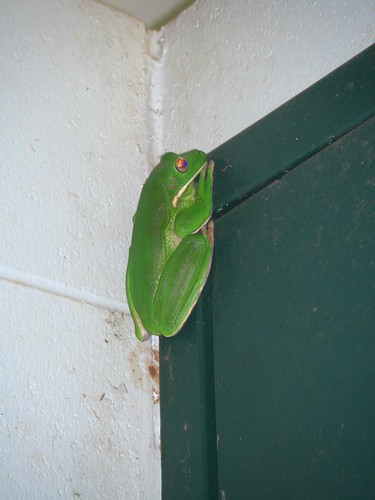
Before leaving Bamaga proper, Linc led us to two sites of crashed WWII airplanes, just southeast of the community. The main site was that of a DC3 aircraft which crash-landed on May 5, 1945 on its way to New Guinea, killing the six people on board.
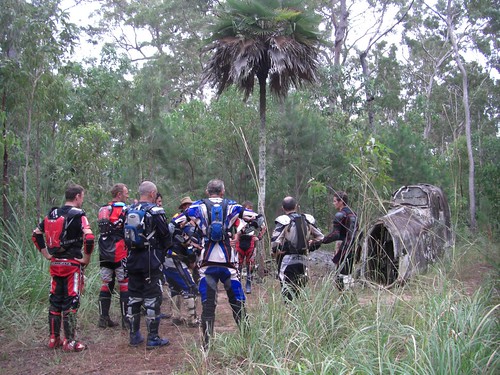
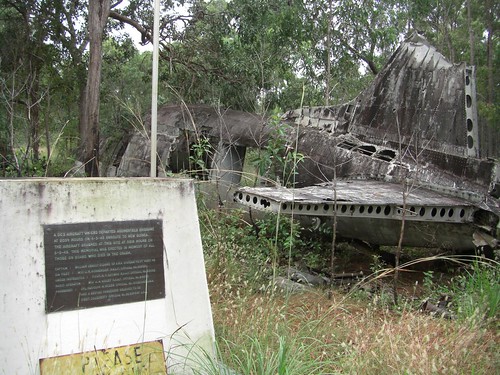
Eight-cylinder rotary engine!
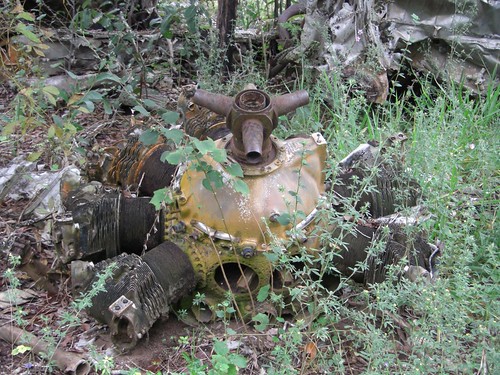
From Bamaga, we took the Northern Bypass Road for about 45 km to the Jardine River ferry. The road is in good condition — dusty of course, and a deep copper red stretching out into the distance. I wasn’t having any trouble at all that morning; I’d slept well and the ride was fun.
The ferry itself is a bit amusing — run by the Injinoo Aboriginal community, the ferry trip is no more than 100 feet across but costs a pretty penny ($90 return for a vehicle; $35 for motorcycles, though that includes Aboriginal permission for any access and/or bush camping north of the Jardine).
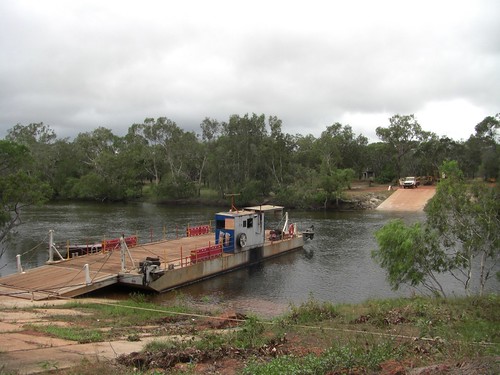
The mighty Jardine.
The Jardine itself is the largest year-round stream in Queensland. Due to its overflowing nature in the wet season (commonly referred to as just “the Wet”), the area surrounding the Jardine is known as “wet desert”. Prior to the Aboriginal ferry, this crossing was one of the major headaches of the 4×4 crowd, not to mention the early explorers (the Jardine brothers, for whom the river was eventually named, originally called it “Deception River” because of its maze of swamps and tributaries). The Jardine is also practically swarming with Estuarine (salt-water) crocodiles, making the ferry a pretty attractive option.
The Jardine River ferry site was also our lunch spot for the day. The truck spilled forth with cold cuts, condiments, and bread choices for sandwiches, as well as corn, tuna salad, and sodas. Learning from the previous day’s mishaps, I had two sandwiches and a Powerade drink that I’d bought at Loyalty Beach.
You’ll notice I had my hat now…
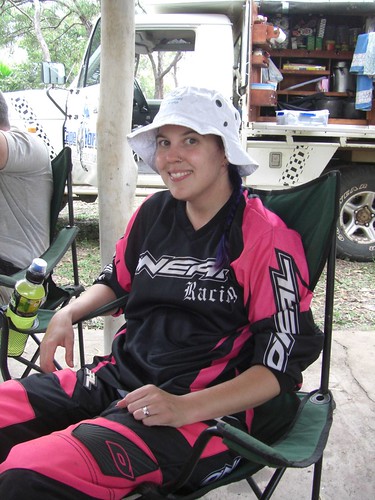
After lunch, the group split up — the more advanced riders took immediately to the Old Telegraph Track, while Dennis, Peter, and I stuck to the Northern Bypass Road for another 50km. The Bypass Roads were built in the 1980s as an alternative to the Old Telegraph Track. They’re longer and “easier” than the OTT but don’t have quite as much….personality.
Look, it’s the Alcan! But red!
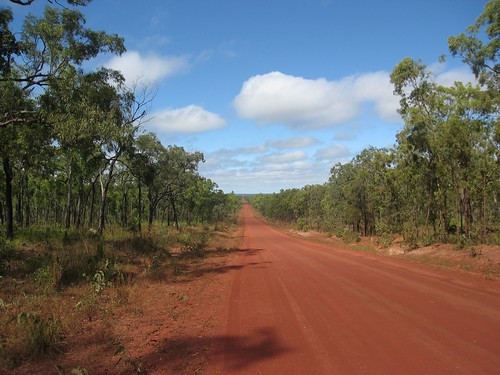
The rough red road, frequently corrugated even this early in the Dry, is covered in little pearls of raw bauxite. Bauxite is largely mined in Weipa, southeast of our path, but this pre-aluminum is found all over the development roads on the Cape. The other ubiquitous landmark of the Cape is the termite mound — often rusty red or dirty grey, the mounds stand between mere inches and many feet tall. After passing approximately fifteen thousand of them, Peter and I finally stopped for photos with this unofficial Queensland mascot.
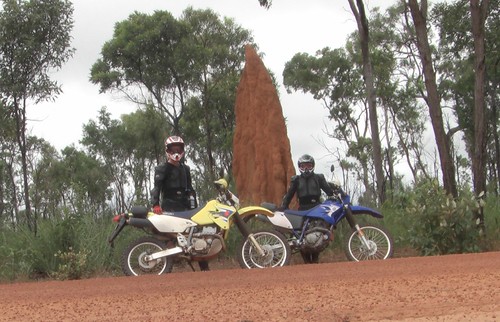
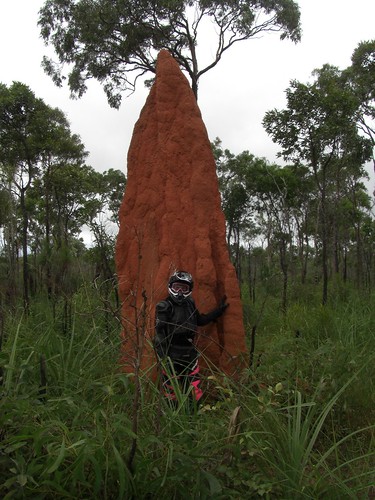
As the Northern Bypass Road met up with the Old Telegraph Track once more, Peter, Dennis, and I headed to the group meeting point — Fruitbat Falls. Since our 50km on the “good” road took much less time than the rest of the groups’ 40km on the OTT with its dozen or so creek crossings, we had a bit of time to play around on our own.
Fun dips and bumps on the road into Fruitbat Falls:
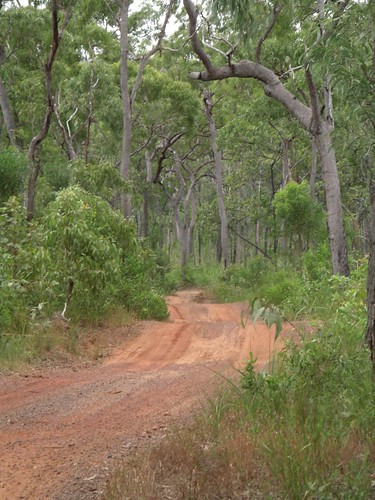
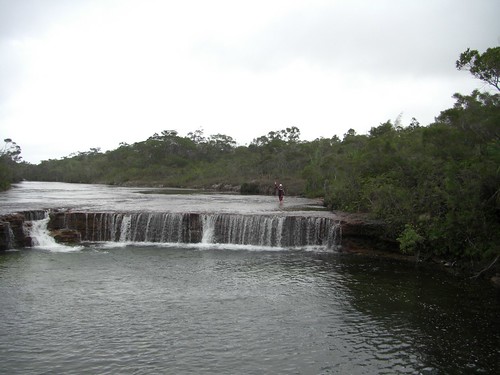
The rest of the group soon arrived and took advantage of the cool croc-free river. Paths give access to the falls on both the upper and lower sides, though some, like Joel, took the quick way between them!
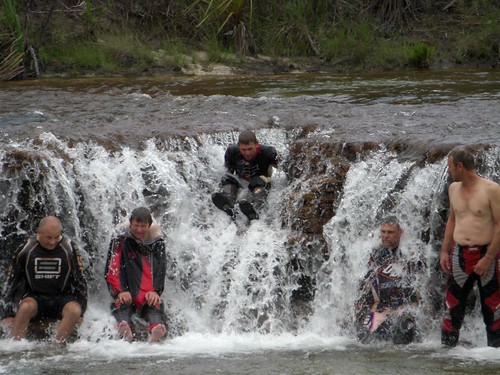
There’s plenty to look at outside the water at Fruitbat Falls, too, including a large number of carnivorous pitcher plants that thrive along the river’s edge. Unfortunately, that means lots of flies, too…though the majority of the ones at the falls were the non-biting kind.
Traveling the OTT.
Our whole group took the Old Telegraph Track south from Fruitbat Falls for another 50km or so to our camp at Bertie Creek. I only did two of the seven or so creek crossings along the way, and happily let Joel ride my bike across for the rest of them. At first I felt badly about “wussing out” this way, but after watching riders much better than me weeble, wobble, and even drown their bikes completely, I swallowed my pride and walked across on foot. That was sometimes hard enough!
A nice slippery creek exit on the OTT:
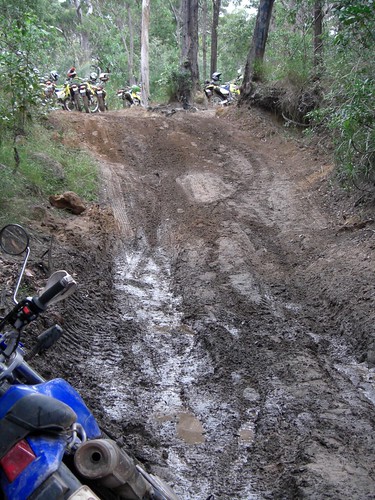
The scenery along the Old Telegraph Track changed slowly but surely from rainforest to scrub, the trees getting shorter and little orange flowers starting to dot the horizon. The open track was too good an opportunity to pass up for the quicker guys in front, and they began to tear along…..at least, until one of the Kiwis, Jack, hit a washout and undulated back and forth across the road until hitting a tree. He seemed fine, if a little shaken up, so Joel fixed a broken turn signal and we continued, if a bit slower after that.
The landscape tightened up as we rode south, the washouts getting deeper and more common, and the visibility around corners shrinking. During one straight section, a wallaby loitering by the side of the road ran out in front of me — far enough ahead that I only needed to tap my brakes, but it woke me up a little!
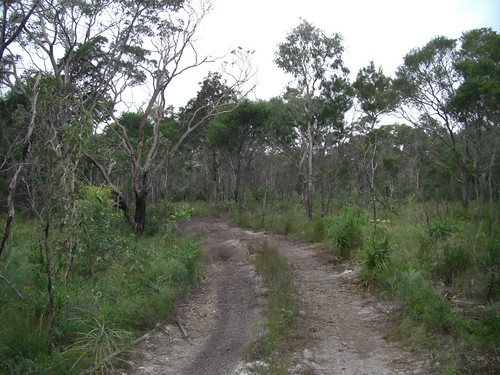
The creek crossings got more and more frequent, and the landscape more and more treacherous, and we slower riders started falling more and more behind. Poor Joel was stuck more or less babysitting us (well, me, mostly) in the last section as we putted slowly but surely over crests and around washouts and through creeks, mud, and sand. I tipped the bike over once in deep sand, but otherwise remained upright….mostly due to asking Joel to ride through the toughest creek crossings!
Peter wasn’t so lucky, and drowned his bike in two creek crossings during the day. The second one was late in the day — as it turned out, we were probably only a kilometer or two from camp, though we didn’t know that at the time — and Joel was getting concerned about darkness. A drowned bike meant Joel removing the fairing panel and air cleaner and trying to get the water out of the engine. The only even vaguely useful thing that we could do to help was to grab the front forks and lift the bike upwards into a tall wheelie at Joel’s command, in the hopes of pouring water from the vents and exhaust. Otherwise, we just stayed out of his way and tried not to feel too guilty. After the second drowning, which took nearly 45 minutes to sort out, I decided to just let Joel ride my bike across the creek after all, even though I had previously been ready to give it a shot.
Bush camping.
We camped that night at Bertie Creek, our first experience “bush camping”. Not only were there no showers or toilets, but no tents or shelter at all. To an experienced camper, that may sound normal, but KOA was the closest I’ve ever previously come to “roughing it”! We set up out cots on a vaguely level patch of rocky sand and spread out our sleeping bags and camp pillows in the rapidly diminishing twilight. The rest of the guys were already seated around the campfire with VBs and snacks; we soon joined in for a wonderful dinner of spaghetti with ground beef and mushrooms. Even out in the bush, Linc made a phenomenal dinner!
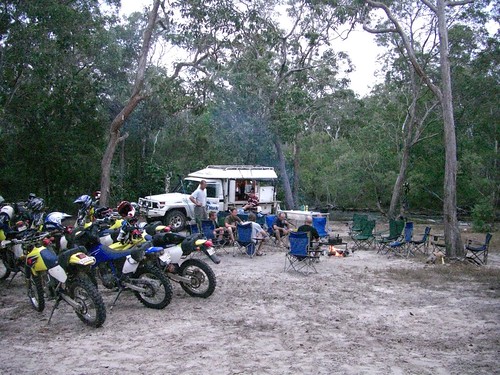
One Response to June 21, 2007: Bamaga – Bertie Creek (168 km)